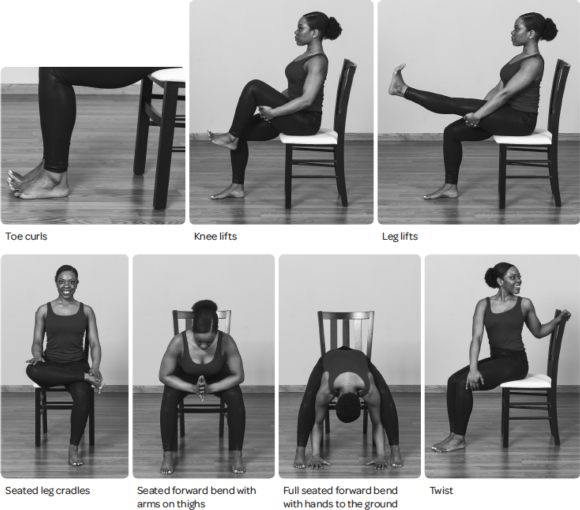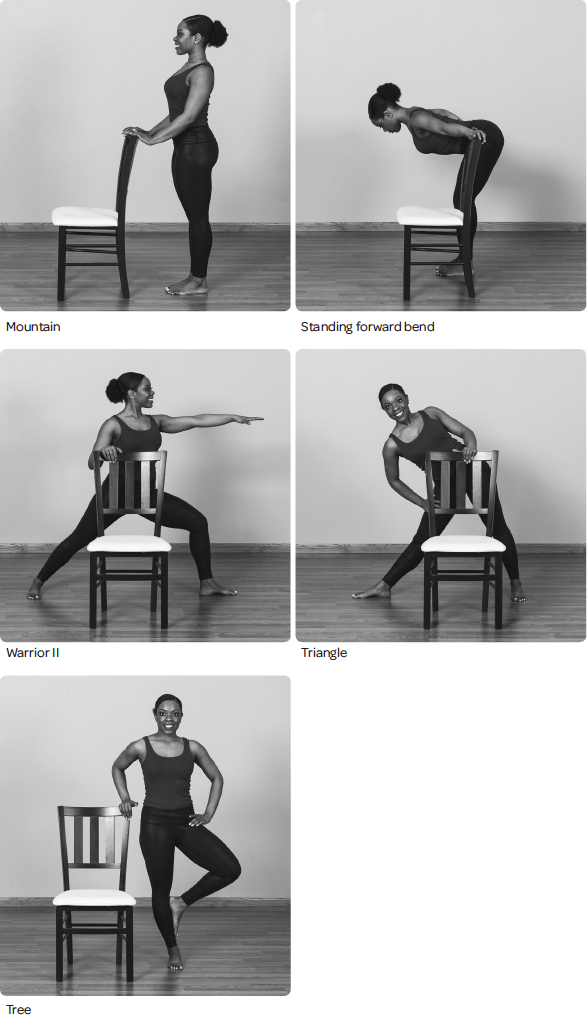Modified chair yoga poses
This is an excerpt from Motivational Yoga by Nancy Gerstein.
Chair Yoga
Intention
To create a motivating yoga workout for students with physical limitations.
Lesson
It may seem implausible, but adapting yoga poses to a chair is a lot like a typical yoga class—the possibilities of movement are endless. With the exception of inverted poses, any posture can be modified while seated or standing with support. The emphasis is on body awareness and grounding, such as how you sit and stand, whether you favor one side over another, or how you're treating your injuries.
Now, become very conscious about how you're seated. Move your spine to the back of the chair, and place your feet on the ground. [If a student's feet don't touch the ground, bring the ground to them by placing a block beneath each foot.] Press the soles of the feet into the ground, feeling a slight awakening of the spine. You're suddenly sitting taller. As you press into the feet again, lift this muscle energy into the calves and thighs. Then, plant your sit bones to rise from the seat of the chair. Feel the torso straightening. Lift the belly and the lower back, allowing that lift into your heart center. Draw the shoulders up, back, and down. Raise the head, crown lifted toward the sky, and chin parallel to the ground. Feel the energy from the floor to the top of your head.
Take some deep cleansing breaths by putting your hands on your abdomen and sending a big inhalation into the lower belly, expanding the navel outward. On the exhalation, release the breath, feeling the belly return to normal. Do it again. Inhaling, expand with oxygen, light and energy; exhaling, release toxins, tensions, and worries. The yoga breathing practices will help calm and energize you, and you can practice them at any time.
Asanas for Deepening
- Wrist and ankle rolls.Subtle movements that may seem too slow in other classes are celebrated in this setting.
- Arm and shoulder stretches. Shoulder rolls, eagle arms, cow face arms (with straps), and face framing (opposite hand to opposite elbow with arms overhead).
- Pelvic tilts. Perform seated cat-cow movements.
- Leg exercises. Include toe curls, ankle rolls, knee lifts, leg lifts with legs crossed and uncrossed to strengthen the hip flexors, and seated leg cradles.
- Forward bend. Spread the feet wide, gently inch forward on the chair away from the back, and rest the forearms on the thighs as you bend at the hips to lengthen the spine. If flexibility allows, slide the hands down the legs to reach the ankles or floor.
- Twist. Turn toward the twisting side, resting a hand on the back of the chair. Lengthen the spine, and gently twist on the exhalation.


Standing Poses
Use a sturdy chair for support. Where possible, place the chair against the wall.
- Mountain.Stand behind the chair, holding the back of the chair for support. Emphasize the importance of weight being distributed evenly between the left, right, front, and back, of the body. For a variation, rise up on the toes.
- Standing forward bend. Standing with one hip facing the back of the chair, place one hand on the chair and the other hand on the hip. Bend forward at the hips, micro-bending the knees, stopping when you meet resistance.
- Warrior II. Stand behind the chair, and place one hand on the top of the chair for support. Alternate the arm lift.
- Triangle. Stand behind the chair, and place one hand on the chair for support. Once in triangle position, rest the leading hand between the waist and the knee for maximum stability.
- Tree. Stand to the side of the chair, holding the back of the chair with one hand. Root the standing leg, and turn the opposite leg out, keeping the foot on the ground. If balance allows, rest the foot on the ankle or calf.

More Excerpts From Motivational Yoga
SHOP

Get the latest insights with regular newsletters, plus periodic product information and special insider offers.
JOIN NOW
Latest Posts
- Authenticity was key to McKinney’s NIL success
- AI—A new tool for sport PR pros
- Essential skills for sport PR practitioners
- Employ these tactics when pitching a story to the media
- How does ergonomic analysis and intervention enhance safety and reduce injury risk?
- Common movement patterns in competitive cycling


